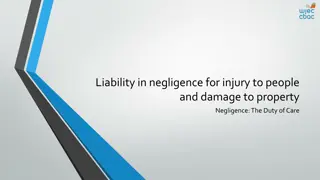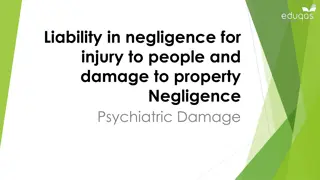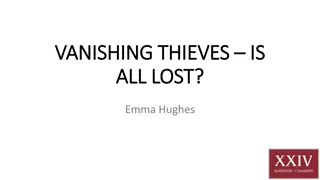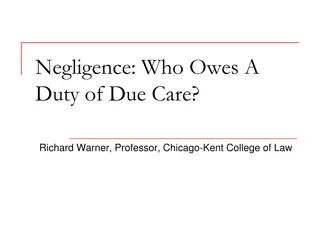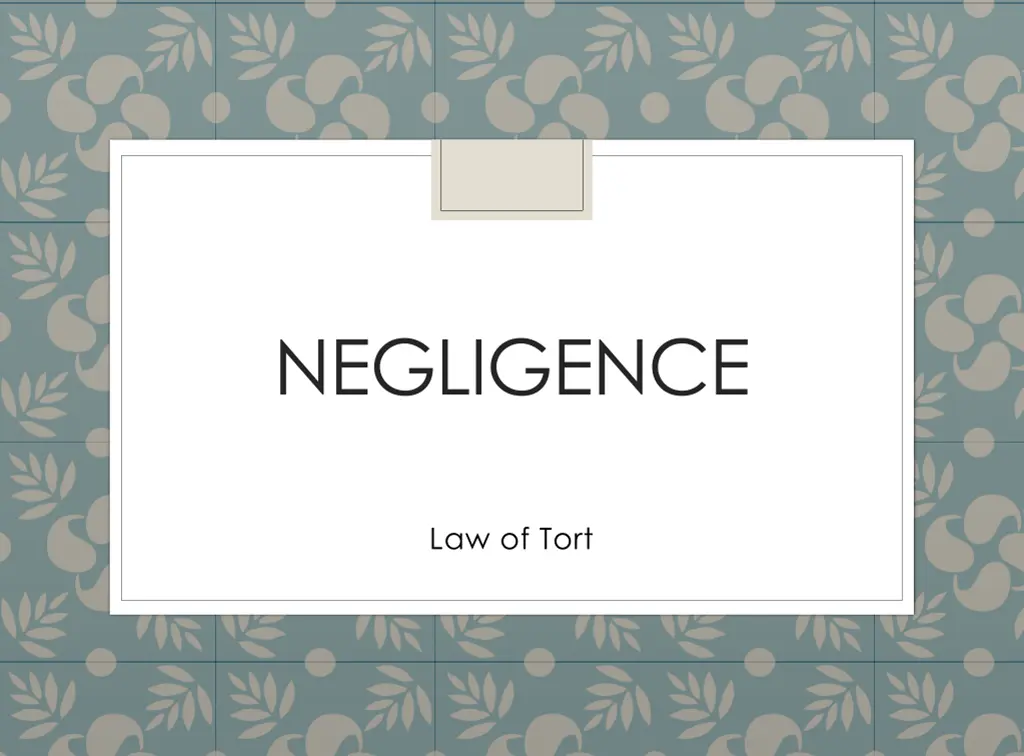
Understanding Negligence Law of Tort and Duty of Care
Explore the concepts of negligence in the law of tort, focusing on the duty of care and breach of duty. Learn about key cases like Paris v. Stepney BC (1951) and principles established by Baron Anderson in Blyth v. Birmingham Waterworks. Understand the importance of foreseeability, proximity, and reasonableness in determining liability for negligence.
Download Presentation

Please find below an Image/Link to download the presentation.
The content on the website is provided AS IS for your information and personal use only. It may not be sold, licensed, or shared on other websites without obtaining consent from the author. If you encounter any issues during the download, it is possible that the publisher has removed the file from their server.
You are allowed to download the files provided on this website for personal or commercial use, subject to the condition that they are used lawfully. All files are the property of their respective owners.
The content on the website is provided AS IS for your information and personal use only. It may not be sold, licensed, or shared on other websites without obtaining consent from the author.
E N D
Presentation Transcript
NEGLIGENCE Law of Tort
Paris v Stepney BC (1951) Apply the rules to see if there is a duty The employer is a neighbour of the employee, who will be affected by the employer s actions. It is foreseeable that not providing goggles could harm a worker. There is clear proximity between an employer and employee, as there is a legal relationship. Whether imposing a duty is fair, just and reasonable is a matter of policy and what is in the public interest. Here it can be said that it is in the public interest to make an employer liable for protection of their staff, and also it will not open the floodgates to claims. An employer doesn t supply goggles to a welder who was already blind in one eye.
Negligence The omission to do something which a reasonable man, guided upon those considerations which ordinarily regulate the conduct of human affairs, would do, or something that a prudent and reasonable man would not do Baron Anderson (Blyth v Birmingham Waterworks) There are three main components that need to be established in order to find someone legally accountable for negligence 1. Duty of Care 2. Breach of Duty 3. Damage/s as a result of the Breach (causation + remoteness)
2: Breach of duty The reasonable man is an ordinary person performing the particular task: he is expected to perform it reasonably competently. Thus, when I am riding my bicycle. I am expected to be a reasonably competent cyclist: when I am building a wall. A reasonably competent wall builder and so on. This has been adopted from the test set out Baron Alderson in Blyth v Birmingham Waterworks (1856) If I fail this test then I am in breach of my duty
2: Breach of duty There are two subcategories within Breach of Duty Types of Reasonable Man (Reasonable man) Factors affecting the standard of care of the reasonable man (Risk factors)
2: Breach of duty Reasonable man Types of Reasonable Man; The ordinary person doing a task The learner The professional Young people
The Ordinary Person (doing a task) Wells v Cooper (1954) D fitted a door handle in his home. C a visitor pulled on the handle and it came away in his hand, causing the visitor to fall down several steps. Held: D was to be judged against the standards of a reasonably competent carpenter, but not necessarily against the standards that would be expected of a professional carpenter working for reward. This was the sort of job that a reasonable householder might do for himself, and that was the appropriate standard. C lost.
The Learner Nettleship v Weston (1971) The defendant was a learner driver. She was taking lessons from a friend. The friend checked that the defendant's insurance covered her for passengers before agreeing to go out with her. On one of the lessons Mrs Weston turned a bend, Mr Nettleship told her to straighten the wheel but Mrs Weston panicked and failed to straighten the wheel. She approached the pavement and Mr Nettleship grabbed the handbrake and tried to straighten the wheel but it was too late. She mounted the pavement and hit a lamp post. Mr Nettleship fractured his knee. The defendant argued that the standard of care should be lowered for learner Held: A learner driver is expected to meet the same standard as a reasonable qualified competent driver. His damages were reduced by 50% under the Law Reform (Contributory Negligence) Act 1945 to reflect the degree to which he was also at fault.
The Professional Bolam v Friern Barnet Hospital Management Committee (1957) Two questions need to be asked; 1.Does the conduct of the defendant fall below the standard of the ordinary competent professional? 2.Is there a substantial body of opinion within the profession that would support the course taken by the professional? Montgomery v Lanarkshire Health Board [2015] The importance of this case is that now any alleged breach of a doctor s duty of care relating to advice given to a patient is no longer determined by applying the Bolam test. The new test is that healthcare providers will not be guilty of negligence when they ensure that a patient is aware of any material risks involved in any recommended treatment, and of any reasonable alternative treatments. The test of materiality is whether a reasonable person in the patient s position would be likely to attach significance to the risk, or the doctor is or should reasonably be aware that the particular patient would be likely to attach significance to it.
The Professional Bolitho v City and Hackney Health Authority (1997) What was the POL here? Roe v Minister of Health (1954) What happened in this case? Why was the defendant found to have met the standard of care?
Young People Where the defendant is not an adult the standard of care expected is that of a reasonable person of that age Mullin v Richards (1998) Two 15 year old school girls were fighting with plastic rulers. A ruler snapped and a splinter went into one of the girls eyes causing blindness. The girl brought an action against the other girl for her negligent action. Held: The girl was only expected to meet the standard of a reasonable 15 year old school girl not that of a reasonable man. She was found not to be in breach of duty.
Experts, professionals and children: Which case? The standard expected is that of an experienced person . Nettleship v Weston 1971 Bolam v Friern HMC 1957 However, professionals must reach the standard of others in their field this is based on medical opinion of what is accepted practice. Bolitho v City & Hackney HA 1997 Such opinion must have a logical basis. Mullins v Richards 1998 Children should reach the standard expected of a child of that age.
AQA June 2015
Homework Task Create A4 overview of the types of Reasonable Man Include cases, POL and key visual prompts

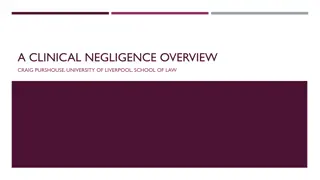

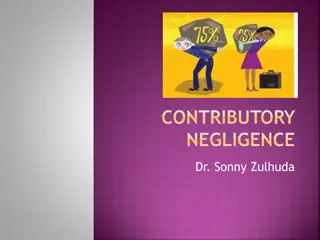
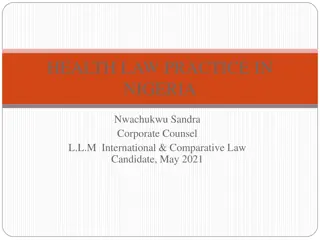



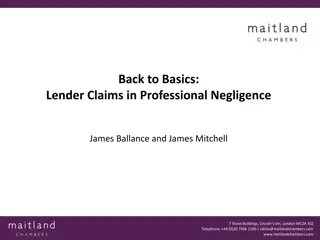
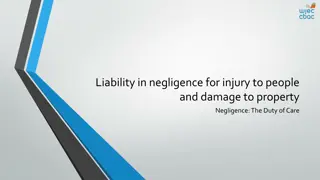
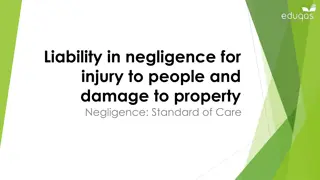



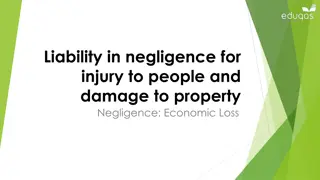
![Negligence Liability in Donoghue v. Stevenson [1932]](/thumb/198881/negligence-liability-in-donoghue-v-stevenson-1932.jpg)
